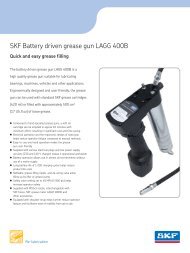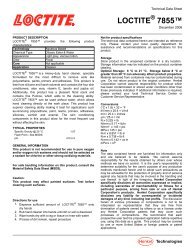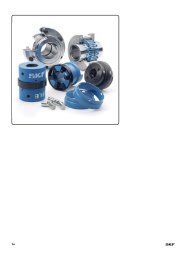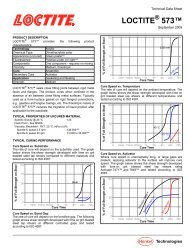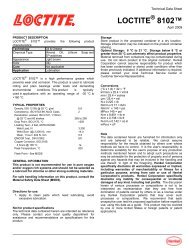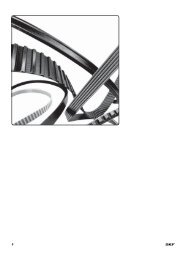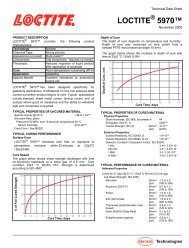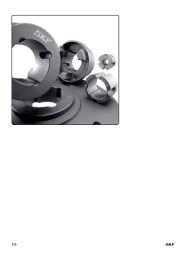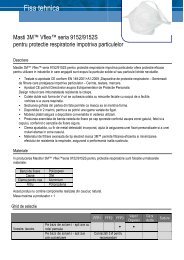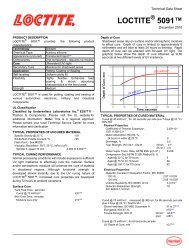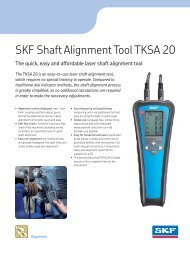- Page 1 and 2: Actuator range
- Page 3 and 4: Principles of actuator and pillar s
- Page 5 and 6: 4 Rotary actuators . . . . . . . .
- Page 7 and 8: At the end of each product informat
- Page 9: Harnessing wind power The growing i
- Page 12 and 13: Linear actuator definition and type
- Page 16 and 17: Application checklist Designing and
- Page 18 and 19: Selection guide Telescopic pillars
- Page 20 and 21: Selection guide Telescopic pillars
- Page 22 and 23: Selection guide Linear actuators AC
- Page 24 and 25: Selection guide Linear actuators AC
- Page 26 and 27: Selection guide Linear actuators DC
- Page 28 and 29: Selection guide Linear actuators DC
- Page 30 and 31: Selection guide Control units Type
- Page 32 and 33: Selection guide Hand switches Type
- Page 34 and 35: Selection guide Desk switch (pneuma
- Page 37: Telescopic pillars AC versions TLC
- Page 40 and 41: Telescopic pillar Telemag TLC Benef
- Page 42 and 43: Telemag TLC Telescopic pillars AC v
- Page 44 and 45: Telescopic pillar Telemag TFG Benef
- Page 46 and 47: Telemag TFG Telescopic pillars AC v
- Page 48 and 49: Telescopic pillar Telemag THC Benef
- Page 50 and 51: Telemag THC Telescopic pillars AC v
- Page 52 and 53: Telescopic pillar Telesmart TXG Ben
- Page 54 and 55: Telesmart TXG Telescopic pillars AC
- Page 56 and 57: Telescopic pillar Telemag TGC Benef
- Page 58 and 59: Telemag TGC Telescopic pillars AC v
- Page 61 and 62: Telescopic pillars - DC versions 2
- Page 63 and 64: Telescopic pillars DC versions Tele
- Page 65 and 66:
Telescopic pillars DC versions Tele
- Page 67 and 68:
Telescopic pillars DC versions Tele
- Page 69 and 70:
Telescopic pillars DC versions Tele
- Page 71 and 72:
Telescopic pillars DC versions Tele
- Page 73 and 74:
Telescopic pillars DC versions Tele
- Page 75 and 76:
Telescopic pillars DC versions Tele
- Page 77 and 78:
Telescopic pillars DC versions Tele
- Page 79 and 80:
Telescopic pillars DC versions Tele
- Page 81 and 82:
Telescopic pillars DC versions Tele
- Page 83 and 84:
Telescopic pillars DC versions CAWA
- Page 85 and 86:
Telescopic pillars DC versions CAWA
- Page 87 and 88:
Telescopic pillars DC versions Tele
- Page 89 and 90:
Telescopic pillars DC versions Tele
- Page 91 and 92:
Telescopic pillars DC versions Tele
- Page 93 and 94:
Telescopic pillars DC versions Tele
- Page 95 and 96:
Telescopic pillars DC versions Tele
- Page 97:
Telescopic pillars DC versions Tele
- Page 100 and 101:
Telescopic pillar FRE guiding tube
- Page 102 and 103:
FRE Telescopic pillars no motor Ord
- Page 104 and 105:
Telescopic pillar TMS Benefits •
- Page 106 and 107:
TMS Telescopic pillars no motor Per
- Page 108 and 109:
106
- Page 110 and 111:
108
- Page 112 and 113:
Linear actuator Magforce SLS Benefi
- Page 114 and 115:
Magforce SLS Linear actuators AC ve
- Page 116 and 117:
Linear actuator Magforce SKS/SKA Be
- Page 118 and 119:
Magforce SKS/SKA Linear actuators A
- Page 120 and 121:
Linear actuator Magforce SKD Benefi
- Page 122 and 123:
Magforce SKD Linear actuators AC ve
- Page 124 and 125:
Linear actuator Magforce STD Benefi
- Page 126 and 127:
Magforce STD Linear actuators AC ve
- Page 128 and 129:
Linear actuator Magforce STW Benefi
- Page 130 and 131:
Magforce STW Linear actuators AC ve
- Page 132 and 133:
Linear actuator Matrix 6 Benefits
- Page 134 and 135:
Matrix 6 Linear actuators AC versio
- Page 136 and 137:
Linear actuator CAR 40 Benefits •
- Page 138 and 139:
CAR 40 Linear actuators AC versions
- Page 140 and 141:
Linear actuator CAHB-31 series Bene
- Page 142 and 143:
CAHB-31 series Linear actuators AC
- Page 144 and 145:
Linear actuator SJ 25, 35, 45 serie
- Page 146 and 147:
SJ 25, 35, 45 series Linear actuato
- Page 148 and 149:
Linear actuator Magforce DSP Benefi
- Page 150 and 151:
Magforce DSP Linear actuators AC ve
- Page 152 and 153:
Linear actuator CAP 32 Benefits •
- Page 154 and 155:
CAP 32 Linear actuators AC versions
- Page 156 and 157:
Linear actuator CAR 32 Benefits •
- Page 158 and 159:
CAR 32 Linear actuators AC versions
- Page 160 and 161:
Linear actuator CAT</strong
- Page 162 and 163:
CAT 32B Linear act
- Page 164 and 165:
Linear actuator CAT</strong
- Page 166 and 167:
CAT 33 Linear actu
- Page 168 and 169:
Linear actuator Magforce WSP Benefi
- Page 170 and 171:
Magforce WSP Linear actuators AC ve
- Page 172 and 173:
Linear actuator CAHB-30 series Bene
- Page 174 and 175:
CAHB-30 series Linear actuators AC
- Page 176 and 177:
Linear actuator CAT</strong
- Page 178 and 179:
CAT 33H Linear act
- Page 180 and 181:
178
- Page 182 and 183:
Linear actuator Magforce SKG Benefi
- Page 184 and 185:
Magforce SKG Linear actuators DC ve
- Page 186 and 187:
Linear actuator Magforce STG Benefi
- Page 188 and 189:
Magforce STG Linear actuators DC ve
- Page 190 and 191:
Linear actuator Runner Benefits •
- Page 192 and 193:
Runner Linear actuators DC versions
- Page 194 and 195:
Linear actuator Matrix 3 Benefits
- Page 196 and 197:
Matrix 3 Linear actuators DC versio
- Page 198 and 199:
Linear actuator CAR 40 Benefits •
- Page 200 and 201:
CAR 40 Linear actuators DC versions
- Page 202 and 203:
Linear actuator Ecomag Benefits •
- Page 204 and 205:
Ecomag Linear actuators DC versions
- Page 206 and 207:
Linear actuator FD series Benefits
- Page 208 and 209:
FD series Linear actuators DC versi
- Page 210 and 211:
Linear actuator Magdrive Benefits
- Page 212 and 213:
Magdrive Linear actuators DC versio
- Page 214 and 215:
Linear actuator CAHB-21 series Bene
- Page 216 and 217:
CAHB-21 series Linear actuators DC
- Page 218 and 219:
Linear actuator Magforce ASM Benefi
- Page 220 and 221:
Magforce ASM Linear actuators DC ve
- Page 222 and 223:
Linear actuator CAP 43B Benefits
- Page 224 and 225:
CAP 43B Linear actuators DC version
- Page 226 and 227:
Linear actuator CAT</strong
- Page 228 and 229:
CAT 32B Linear act
- Page 230 and 231:
Linear actuator Matrix 1 Benefits
- Page 232 and 233:
Matrix 1 Linear actuators DC versio
- Page 234 and 235:
Linear actuator CAR 32 Benefits •
- Page 236 and 237:
CAR 32 Linear actuators DC versions
- Page 238 and 239:
Linear actuator CAP 32 Benefits •
- Page 240 and 241:
CAP 32 Linear actuators DC versions
- Page 242 and 243:
Linear actuator CAP 43A Benefits
- Page 244 and 245:
CAP 43A Linear actuators DC version
- Page 246 and 247:
Linear actuator CAT</strong
- Page 248 and 249:
CAT 33 Linear actu
- Page 250 and 251:
Linear actuator CAHB-20 series Bene
- Page 252 and 253:
CAHB-20 series Linear actuators DC
- Page 254 and 255:
Linear actuator CARE 33 Benefits
- Page 256 and 257:
CARE 33 Linear actuators DC version
- Page 258 and 259:
Linear actuator CAR 22 Benefits •
- Page 260 and 261:
CAR 22 Linear actuators DC versions
- Page 262 and 263:
Linear actuator CAT</strong
- Page 264 and 265:
CAT 33H Linear act
- Page 266 and 267:
Linear actuator CAHB-10 series Bene
- Page 268 and 269:
CAHB-10 series Linear actuators DC
- Page 270 and 271:
Linear actuator CALA 36A Benefits
- Page 272 and 273:
CALA 36A Linear actuators DC versio
- Page 274 and 275:
Linear actuator CAT</strong
- Page 276 and 277:
CAT 21B Linear act
- Page 278 and 279:
3917990 Detailed drawings of front
- Page 280 and 281:
278
- Page 282 and 283:
Linear actuator CARN 32 Benefits
- Page 284 and 285:
CARN 32 Linear actuators no motor P
- Page 286 and 287:
Linear actuator CCBR 32 Benefits
- Page 288 and 289:
CCBR 32 Linear actuators no motor P
- Page 290 and 291:
288
- Page 292 and 293:
Rotary actuator CRAB 17 Benefits
- Page 294 and 295:
CRAB 17 Rotary actuators Performanc
- Page 296 and 297:
CRAB 17 Rotary actuators Motor asse
- Page 298 and 299:
Rotary actuator CRAB 05 Benefits
- Page 300 and 301:
CRAB 05 Rotary actuators Performanc
- Page 302 and 303:
300
- Page 304 and 305:
Control unit SCU Benefits • Compa
- Page 306 and 307:
SCU Control units Pinning of HD15 l
- Page 308 and 309:
Control unit VCU Benefits • Compa
- Page 310 and 311:
VCU Control units Pinning of HD15 l
- Page 312 and 313:
Control unit BCU Benefits • Compa
- Page 314 and 315:
BCU Control units Ordering keys B C
- Page 316 and 317:
Control unit CB Benefits • Compac
- Page 318 and 319:
Control unit MCU Benefits • Suita
- Page 320 and 321:
Control unit LD-01
- Page 322 and 323:
Control unit LD-01
- Page 324 and 325:
Control unit CAED ANR Benefits •
- Page 326 and 327:
Control unit CAED Benefits • Comp
- Page 328 and 329:
Control unit CAEV Benefits • Reli
- Page 330 and 331:
CAEV Control units Connecting diagr
- Page 332 and 333:
330
- Page 334 and 335:
Hand switch EHA 1 Benefits • Robu
- Page 336 and 337:
Hand switch EHA 3 Benefits • Robu
- Page 338 and 339:
Hand switch EHE 1 Benefits • Easy
- Page 340 and 341:
Hand switch HS Benefits • Robust
- Page 342 and 343:
Pneumatic hand switch PHC Benefits
- Page 344 and 345:
Hand switch CAES Benefits • Robus
- Page 346 and 347:
Foot switch ST Benefits • Easy an
- Page 348 and 349:
Pneumatic foot switch PFP Benefits
- Page 350 and 351:
Desk switch ST Benefits • Easy an
- Page 352 and 353:
Desk switch LD Benefits • Easy an
- Page 354 and 355:
Pneumatic desk switch PAM Benefits
- Page 356 and 357:
354
- Page 358 and 359:
Rotary actuators Benefits • Outdo
- Page 360 and 361:
Compact electromechanical cylinder
- Page 362 and 363:
Compact electromechanical cylinder
- Page 364 and 365:
Modular electromechanical cylinder
- Page 366 and 367:
364
- Page 368 and 369:
Electronic cable puller actuator fo
- Page 370 and 371:
EPB Drive by wire Connections* Pin
- Page 372 and 373:
370
- Page 374 and 375:
CAR 22 - Type codes for accessories
- Page 376 and 377:
CARN 32 - Type codes for accessorie
- Page 378 and 379:
CAT 32B - Type cod
- Page 380 and 381:
Limit switches Spare parts CAXC 33
- Page 382 and 383:
Feedback for CAT s
- Page 384 and 385:
Notes 382
- Page 386 and 387:
Notes 384
- Page 388:
skf.com



